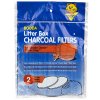Reiss
Well-Known Member
Just thought I'd share my info..
I grow in a small closet in my spare room in my flat, the smell in that room is always an issue when I'm flowering and tends to make my whole flat smell too.
I bought an air ioniser off ebay (£30) tried it this morning and with 5 mins, couldn't smell a thing! even cleared my cig smoke away within seconds.
Not sure how effective this would be on big grows, but for my stinky 1 plant grow I would highly recommend one.
If anyone in the UK wants a link to the ioniser, let me know.
I grow in a small closet in my spare room in my flat, the smell in that room is always an issue when I'm flowering and tends to make my whole flat smell too.
I bought an air ioniser off ebay (£30) tried it this morning and with 5 mins, couldn't smell a thing! even cleared my cig smoke away within seconds.
Not sure how effective this would be on big grows, but for my stinky 1 plant grow I would highly recommend one.
If anyone in the UK wants a link to the ioniser, let me know.

